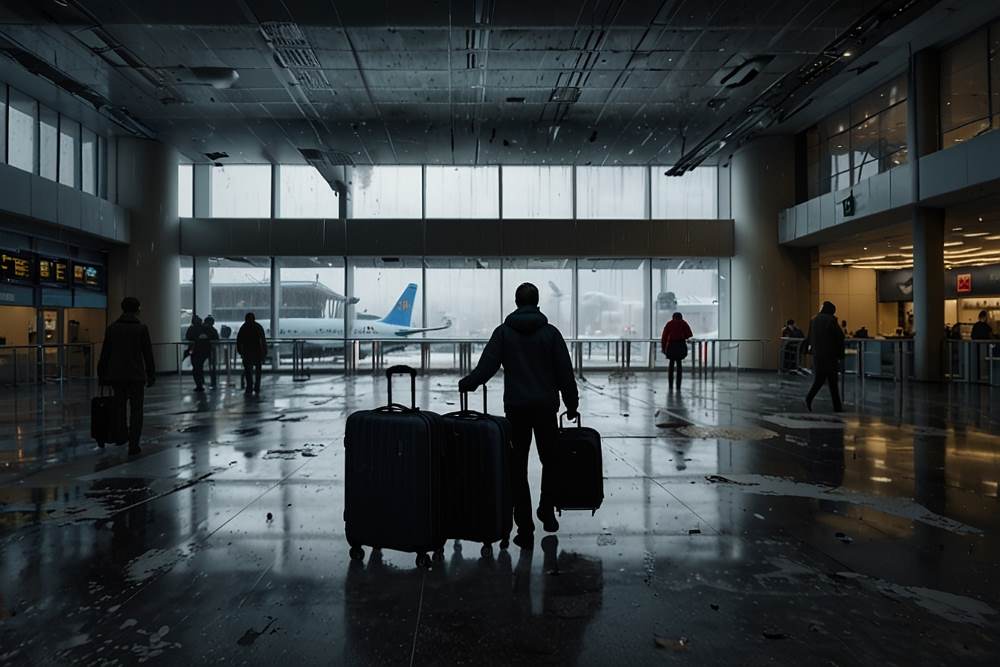Published on November 4, 2025
In an unprecedented wave of air travel devastation across the U.S., Austin-Bergstrom International Airport has joined Houston George Bush Intercontinental, Newark Liberty International, Los Angeles International, La Guardia, and San Diego Airport in facing significant disruptions. Staffing shortages at these major airports have caused major delays, leaving passengers in a state of distress. With air traffic control towers understaffed and TSA lines growing longer, travelers have been forced to endure hours of waiting. This widespread issue is not only frustrating passengers but is also disrupting flight schedules across the country. The staffing crisis has left these airports struggling to manage the surge in air traffic, particularly during peak travel periods. As a result, thousands of travelers are experiencing a ripple effect of delays, missed connections, and overall chaos. This ongoing situation highlights the urgent need for better staffing solutions to prevent further travel disasters.
What Is a Ground Delay and Why Did the FAA Issue It?
A ground delay is an air traffic control measure used when the number of incoming flights is higher than the capacity of the airport to handle them. This often leads to delays because the air traffic controllers have to space out arrivals to avoid congestion. The FAA steps in to manage the flow of air traffic to ensure safety and efficiency.
In this case, the FAA issued a ground delay for Austin-Bergstrom International Airport due to staffing issues. This means the airport’s air traffic control team didn’t have enough staff to manage the incoming flights smoothly. As a result, the FAA had to implement a delay program to control the flow of aircraft arriving at AUS.
What Was the Duration of the Delay at Austin-Bergstrom?
The delay at Austin-Bergstrom started at around 3:30 p.m. local time and continued until 7:59 p.m. The total delay lasted for over four hours, which is a significant amount of time in the fast-paced world of air travel. The delay was not just a minor inconvenience. It was a serious event that affected numerous flights arriving at the airport during that time.
While these delays were expected to cause significant waiting time, the average delay was reported to be around 58 minutes. However, some flights faced even longer waiting periods, and the maximum delay reached 89 minutes. These delays were not only frustrating for passengers but also put pressure on airlines and staff who had to adjust their schedules accordingly.
Why Did Staffing Issues Lead to a Ground Delay?
When we think of air traffic control, we often picture people sitting in towers, guiding planes in and out of airports. The reality is that air traffic control is a highly skilled job that requires precise coordination to ensure the safety of all flights. It’s a job that requires a lot of training and, most importantly, people.
Advertisement
Advertisement
In Austin’s case, the FAA revealed that the staffing shortage at the control tower was the root cause of the delay. This means that there were not enough air traffic controllers available to manage the usual amount of incoming flights at the airport. The shortage of staff could have been due to a variety of reasons, including holiday scheduling, illness, or an unexpected gap in staff coverage.
Whatever the reason, the result was clear: planes had to be delayed to ensure that air traffic controllers were not overwhelmed. This also prevented the risk of accidents and ensured that flights could be handled in an orderly manner.
The Impact on Passengers
For the passengers stuck waiting at the airport or on their planes, the situation was no doubt frustrating. Travelers who were planning to arrive at their destinations on time found themselves delayed for an hour or more. This led to missed connections, changes to travel plans, and general frustration.
Airlines, too, had to adapt to the situation. With the FAA’s ground delay program in effect, flight crews had to adjust their schedules. Many airlines issued notices to their passengers, informing them about the delays and suggesting they stay in touch with the airline for up-to-date information. Passengers were advised to check the status of their flights regularly and connect directly with their airlines for assistance.
Houston Airport Faces Unprecedented Delays Due to Federal Shutdown
In addition to issues at Austin-Bergstrom, Houston Airport, one of America’s busiest, has also been hit hard by the ongoing federal shutdown. This has led to massive delays at the airport, with travelers reporting hours-long waits just to get through security. The TSA is operating with limited staff, and the air traffic control towers are similarly understaffed, leading to further delays in both arrivals and departures.
The shutdown has affected not just Houston but airports across the country, highlighting a larger issue within the U.S. aviation system. With a surge in passengers during peak travel times, it’s become evident that many airports, including Houston, are unprepared to handle the strain of this situation. The federal shutdown has exposed vulnerabilities in staffing and resources that are critical to maintaining a smooth and safe travel experience.
Comparing Similar Delays at Other Airports
Austin-Bergstrom International Airport is not alone when it comes to facing staffing shortages and delays caused by air traffic control issues. Airports across the United States have experienced similar situations in recent months.
For example, in Newark Liberty International Airport (EWR), the FAA issued a ground stop due to staffing shortages, resulting in delays that ranged from 116 minutes to 212 minutes. Similarly, Los Angeles International Airport (LAX) and San Diego International Airport (SAN) also had ground delays due to air traffic control staffing shortages. These delays often have a ripple effect, disrupting schedules across the country as planes are forced to stay in place.
These delays show a bigger issue: staffing shortages in air traffic control are not isolated incidents. Airports around the country are facing challenges in managing their air traffic control teams, leading to delays and disruptions that affect both passengers and airlines. This highlights a need for more resources and better staffing strategies to prevent such delays in the future.
The FAA’s Role in Managing Air Traffic
The FAA’s role is to ensure the safe and efficient movement of air traffic. When there are too many flights coming into an airport, it’s the FAA’s responsibility to control the flow. One of the ways they do this is through Ground Delay Programs (GDPs).
Ground Delay Programs are designed to manage how many flights can arrive at an airport at any given time. By issuing a delay, the FAA prevents congestion at the airport and gives air traffic controllers enough time to manage incoming flights safely. The program helps ensure that planes are spaced out in a way that keeps air traffic moving without compromising safety.
Ground Stops, on the other hand, are more severe. These occur when the FAA stops flights from departing for a destination airport altogether. While Ground Delays affect only the arrival process, Ground Stops prevent flights from leaving the departure airports, which can cause massive ripple effects for airlines.
The Importance of Air Traffic Control Staff
The events at Austin-Bergstrom bring attention to the critical role air traffic controllers play in keeping air travel safe and on schedule. Air traffic control is not an easy job – it requires a great deal of training, focus, and precision. These professionals are responsible for ensuring that flights are properly spaced out, that aircraft avoid each other, and that they are cleared for safe landing.
When there is a shortage of staff, the entire system can become strained. Airports like Austin-Bergstrom rely on having a sufficient number of controllers to manage the traffic flow. Without enough staff, the delays and disruptions that passengers experience can become inevitable.
In this context, the need for better staffing solutions and backup plans for air traffic control becomes more urgent. Airports must plan ahead to ensure they have the right number of air traffic controllers available, especially during peak travel times or when unexpected staffing shortages arise.
How Can the Situation Be Prevented in the Future?
The ongoing issue of staffing shortages at airports, leading to ground delays, calls for better planning and resources. It’s clear that air traffic control systems need to be bolstered to prevent these types of delays. Here are a few possible steps to reduce delays in the future:
- Increasing Staffing Levels: One of the most effective solutions would be to increase the number of air traffic controllers. By having enough staff available to manage the flow of air traffic, the risk of delays due to staffing shortages can be minimized.
- Improved Scheduling: Ensuring that air traffic control teams are appropriately scheduled, especially during peak travel times, would help address the issue. Airports need to plan their staffing needs well in advance to cover all shifts.
- Better Training and Retention Programs: Ensuring that air traffic controllers are well-trained and motivated to stay in the job is essential. Improved retention rates can help reduce the impact of staffing shortages.
- Technology Upgrades: The aviation industry should continue to explore ways in which technology can help alleviate the burden on air traffic controllers. Automation, artificial intelligence, and better tools can help controllers manage air traffic more efficiently.
A wide group of travel industry organizations, led by the U.S. Travel Association, is calling on Congress to pass a clean continuing resolution to reopen the federal government. Nearly 500 companies and groups, including hotels, casinos, and convention bureaus, signed a letter sent to congressional leaders today.
With Thanksgiving just around the corner, the coalition warns that a prolonged shutdown could lead to significant travel disruptions, longer TSA lines, and billions in lost economic activity. Last year, more than 20 million passengers flew in the U.S. during Thanksgiving week.
Conclusion
The FAA’s ground delay at Austin-Bergstrom International Airport due to staffing issues serves as a stark reminder of how reliant air travel is on the men and women who manage air traffic. Without sufficient staff, airports struggle to maintain the smooth flow of arrivals and departures. While this may seem like a minor inconvenience to passengers, it has far-reaching effects on the entire aviation system.
As airlines, airports, and the FAA work together to tackle staffing shortages, it’s clear that the future of air travel will require careful planning and innovation to keep things running smoothly. With the right adjustments, we can ensure that delays like those seen at Austin-Bergstrom become a rare occurrence and that air travel remains as safe and efficient as possible.
Source: FAA
Advertisement
Advertisement
Tags: air travel chaos, airport delays, flight disruptions, Staffing Shortages, TSA delays
Subscribe to our Newsletters
I want to receive travel news and trade event updates from Travel And Tour World. I have read Travel And Tour World's Privacy Notice .
Tuesday, November 4, 2025
Tuesday, November 4, 2025
Tuesday, November 4, 2025
Tuesday, November 4, 2025
Tuesday, November 4, 2025
Tuesday, November 4, 2025
Tuesday, November 4, 2025
Tuesday, November 4, 2025




